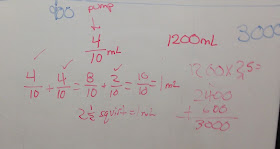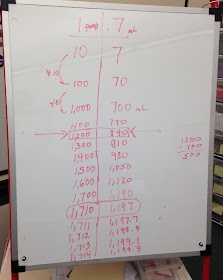One of the most important habits a math teacher can develop is to do the problem first, always.
pg. 46
I had our custodian open up the dispenser.
 |
| She's gotten used to these kinds of requests. |
She showed me a refill, and I found out that each bag held 1,200 mL of liquid soap.
But how much soap came out in each squirt? A call to Georgia Pacific and I had my answer.
| The dispenser has two settings: one for 0.4 mL and another for 0.7 mL. |
We couldn't determine where the dispenser was set, and I worked out the answer for the 0.4 setting.
After a false start...
 |
| 113 is wrong! |
...I figured it out. 3,000 squirts!
I was curious to see how Rich and Megan (our grade 5 resource room teacher) would attack the problem, so I asked them to have a go:
 |
| Rich's solution. While I thought of four tenths as a decimal, he used a fraction. |
 |
| Megan also thought in fractional terms. |
I thought it was interesting that the three of us took three different solution paths, and we imagined we'd see a variation in the class responses.
For Act 4, we thought we'd ask the kids to find out how many squirts it would take to empty the bag if the dispenser was set at 0.7 mL per squirt. Megan had to leave, so that left Rich and I to work it out.
 |
| I went back to my table. It had worked before. Why not again? |
 |
As I started to puzzle it out, the phone rang. It was Rich. He had gone back to his room, divided 1200 by .7 and gotten a wacky decimal. "It's 1,714.285714," he said, "And it goes on." I got out my phone calculator, punched in the numbers, and got 1,714.28571429. I knew that the answer lay somewhere between 1,714 and 1,715, but where did that ugly decimal come from? What did it mean? If there was 0.2 mL left in the dispenser, wouldn't the answer be 1,714.2? Or maybe it was 0.2 of 0.7? But then that would leave an answer of 1,714.14 squirts.
No kidding, I stared at the whiteboard for the better part of a week, thinking about decimals, automatic soap dispensers, and Robert Kaplinsky on productive struggle.
 |
| The decimal was killing me! |
I finally broke down and called my supervisor. He was fascinated by the way I went about solving the problem, and he picked up a marker and started working in the bottom right corner.
So how did the 3-Act play out with the kids? Stay tuned for a report. But because we had worked out the problem beforehand, Rich and I felt ready for anything.
A postscript:
Curious about the decimal, I did a little research. Turns out it's a repeating decimal, and the part that repeats is called the period or repetend, and there are cool patterns that occur with the digits. I tried dividing 2 by 7, first by hand...
...and then on different calculators:
They were all different, because some of them rounded and some of them didn't! I started to like the decimal, and had to revise my opinion. What I first thought of as something ugly turned out to be rather cool!
Tracy gets the final word:
Playing with the problem ourselves activates our identities as mathematicians. Just like reading teachers need to read and writing teachers need to write, math teachers need to do math. Noticing which mathematical concepts and techniques come into play while we work focuses our thinking on content. Rather than jumping right to planning activities students will do, we spend time thinking about the mathematics students may learn.









I've had a lot of those knock yourself on the head moments. Often, somehow, they seem to come eith the same problems where doors open. I wonder why that is?
ReplyDeleteI agree that these moments arise when problems are juicy. And then maybe it also has to do with the solver. I know in this case I was pursuing something a little beyond the actual problem, because I could have been satisfied with just 1,714 full pumps and then left the decimal alone. So how do we build the curiosity and desire to walk through the open door and head into the unknown?
ReplyDeleteThat's a really good question. The curriculum my school is following now, the Primary Years Program of the International Baccalaureate, puts emphasis on students being inquirers. To me, that's about walking through that door, asking and following a question you don't have to. It's very difficult to achieve because school gets students, quite naturally, expecting to take the lead from teachers. This is what I wrestle with lots.
DeleteJudging from your posts and tweets documenting the work you and your colleagues are doing, I'd say your school is doing a great job building inquiring minds. Yes, students expect teachers to take the lead, but teachers also expect to take the lead, that's the contract! So both sides have to give a bit.
ReplyDelete